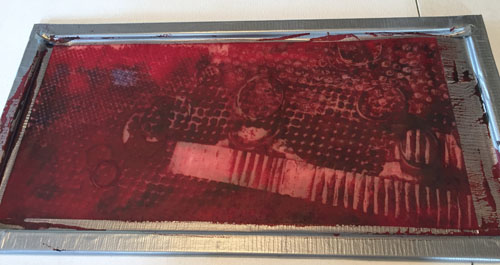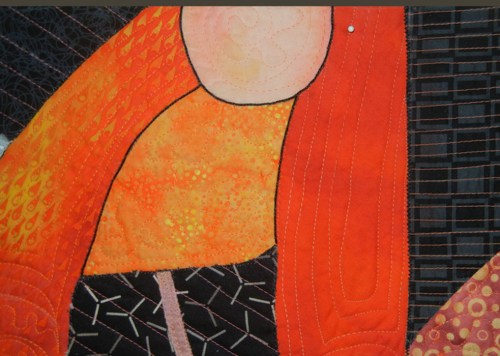Now, THIS is exciting stuff! After doing deconstructed screen printing with randomly created screens, I decided to draw on my last screen, with a syringe. This is a technique I learned in a DSP class with Kerr Grabowski.

That’s my screen above. I drew on it with very thick black dye. In fact, it was actually too thick and it came out in glops and curly-Qs. None of which mattered for my purposes.
And here’s the first pull with that screen. You can barely see the clear dye paste I used on the far right.

Is that cool or what? Some of the dried dye in the screen has dissolved with the print paste and has given a little gray color. But, the heavy black lines are thick enough to act as resists and they’ve created white lines. Not what you’d expect, right?
The first few pulls with colorless paste looked somewhat similar. Here’s a more detailed shot.

Before I show you the rest of my results, here’s more of an overview, using Gabriele DiTota’s work as examples. She was our ring leader for the day and she got some great results. Here are her first few pulls with her syringe-drawn screen. (She was smart enough to thin the black dye paste so she avoided the gloppy curly-Qs.)

After a few of these colorless pulls, she switched to red dye.

The red dye colored the background, but the drawn squeegee lines still created a resist resulting in white lines. Pretty cool, right?

Like Gabriele, I decided to add a background color to my efforts. I was aiming for blue-green, but I initially got mostly green. As I slowly added more blue, I pulled screen after screen, resulting in a run of blues and greens.
Below you can see the detail of the first couple of pulls on the left and later colored ones on the right. As you can see, the drawn design is beginning to break down on the right and the details are fading. No worries. It’s just a different design.

I got carried away and added a bit too much black to the one on the far right. The fabric is wet in this photo, so it looks especially vibrant.

And here’s the full run, washed and dried. As you can see, it lost a lot of color in the wash, but I still love it!

A super close up.

I LOVE these results! If I ever do DSP again, I think I’ll do this sort of drawing on all my screens!
Now, what will I do with all this luscious fabric? That shouldn’t be a problem!
Ellen Lindner































 One of my readers, Suzanne Sanger, decided to give it a try and was kind enough to share her results with me (and with you.)
One of my readers, Suzanne Sanger, decided to give it a try and was kind enough to share her results with me (and with you.)

























